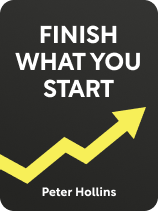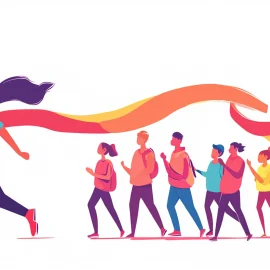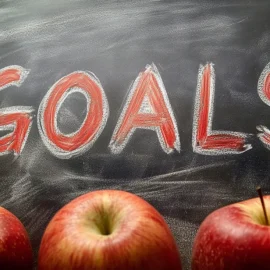

This article is an excerpt from the Shortform book guide to "Finish What You Start" by Peter Hollins. Shortform has the world's best summaries and analyses of books you should be reading.
Like this article? Sign up for a free trial here.
How can you make a project less daunting? What strategies can increase both your motivation and your productivity?
Peter Hollins explores effective project preparation techniques in his book Finish What You Start. He offers insights on leveraging extrinsic motivation, creating visual reminders, and breaking tasks into manageable steps.
Continue reading to discover five key actions to take before you start a project.
Project Preparation
Once you’ve started developing a productivity mindset, you’ll be somewhat motivated to put in the work required to achieve your life goals. But Hollins argues that there’s no need to rely solely on your mindset for motivation. If you prepare properly before you start working, you can plant the seeds for future motivation and make your tasks much easier to overcome.
Here are five actions you can take during the project preparation phase.
Action #1: Set Up Sources of Extrinsic Motivation
Hollins advises setting up ongoing sources of extrinsic motivation. Although internal motivators are generally more effective in the long run, supplementing them with short-term extrinsic motivators can boost your productivity.
One effective source of extrinsic motivation is social pressure. Ask someone in your life to regularly do motivational check-ins with you. They should know when you need to take productive action, get in touch to make sure you do, and express their disappointment if you fail to act. The threat of letting this person down will motivate you to get things done.
(Shortform note: Unfortunately, social pressure can also be a negative and demotivating force in your life. In The Willpower Instinct, Kelly McGonigal explains that your brain has “mirror neurons” that make you empathize with others’ actions and emotions: If you see someone close to you indulging in an unhealthy habit, your brain will crave a similar reward, and you’ll be more likely to give into something similarly unhealthy. To avoid falling into this trap, surround yourself with people who share your goals or have high levels of willpower. Positive behaviors are contagious—being around disciplined people can boost your self-control.)
According to Hollins, another way you can leverage extrinsic motivators is by setting up a situation in which you lose or waste a significant amount of money if you fail to take productive action. For example, purchase a year’s subscription to a sophisticated diet-tracking app. You’ll be motivated to track the food you eat so the money you spent on the app doesn’t feel wasted.
Hollins asserts that you may find it useful to combine these two strategies: Give a friend a sum of money, then tell them not to return it until you complete your goal. This way, you’re motivated by the fear of losing money and looking bad in front of someone you care about.
| The Downside of Extrinsic Motivation While Hollins argues that extrinsic rewards can be useful as a supplement to intrinsic ones, you may not want to rely too much on these strategies. In Drive, Daniel H. Pink warns that external rewards can significantly decrease your intrinsic motivation for the same goals by making you feel like you have less autonomy. Imagine doing an activity like painting or writing just because you love it. Now think about how that might change if you felt like you had to paint or write at the risk of losing a lot of money. This compulsion might make the same activity feel more like a job than a pleasure. |
Action #2: Create a Reminder of What’s Motivating You
Hollins recommends creating a persistent reminder of your extrinsic and intrinsic motivators so they’re always at the front of your mind. This reminder can be anything you associate with your motivators. For instance, you could keep a rock from your vacation to Iceland on your desk to remind you of your intrinsic motivation to be more adventurous in your day-to-day life. Alternatively, if you’re leveraging extrinsic motivation by asking a friend to make sure you’ve written a new song every week, you could change your computer’s desktop background to a picture of their face.
As these examples illustrate, you should put the reminder somewhere you’ll engage with it frequently. Ideally, whenever you encounter your reminder, it’ll snap you out of unproductive mental habits like rumination and motivate you to take action. Make this reminder as prominent as possible so you don’t overlook it.
(Shortform note: It’s possible to go overboard when creating a visual reminder of your motivators. Many people recommend creating vision boards to boost your motivation—collages of pictures and affirmations that represent your dreams and goals. However, research warns that vision boards can actually decrease motivation: Your brain processes the images on your board as though you’ve already attained them, reducing your drive to put in the necessary work. Instead of frequently focusing on a vision board, visualize yourself taking action, which research shows is more effective.)
In addition to creating a reminder of what’s motivating you, Hollins recommends making a scoreboard, a visual depiction of your progress on your goals. This is essentially a large to-do list posted somewhere you can see it frequently: Write down tasks you need to accomplish and cross them off as you complete them.
Like your other, more general reminder, seeing this scoreboard will motivate you to act. The goal is to make completing tasks feel like you’re winning a game. Promise yourself a treat as a “prize” for accomplishing a major task down the road. Celebrating the steps you take toward this prize will motivate you to continue.
| Make Your Scoreboard Instantly Graspable The authors of The 4 Disciplines of Execution also recommend building an easily visible scoreboard to serve as an ongoing source of motivation. To make this scoreboard as motivating as possible, they recommend designing it to be easily readable: You should be able to instantly tell if you’re “winning” or “losing” (that is, whether you’re on track to achieve the goals you’ve set). One way to do this is to use color coding—color your scoreboard green if you’re winning and red if you’re losing. Unlike Hollins, the authors don’t explicitly recommend offering a prize for when you “win the game.” Instead, they contend that people have natural competitive instincts that motivate them to work hard when they see a way to win a game in which their score is being clearly tracked. |
Action #3: Create Strict Rules for Yourself
Hollins suggests writing a set of rules to help you follow through on your goals. Once you get in the habit of following certain rules, they allow you to make decisions automatically instead of relying solely on willpower to drive healthy behavior.
He explains that these useful rules come in two types: restrictions that cap the amount of unproductive actions you’re allowed to take and obligations that outline actions you must take. To ensure your restrictions and obligations are as effective as possible, make them precise and concrete. Design them to apply every day, so you’re constantly making progress toward your goals. For example, you could set the restriction that you can’t watch more than two episodes of a TV show per day, or set the obligation that you must eat a portion of fruits and vegetables with every meal.
| Habitual Action Creates Neural Connections In The Happiness Advantage, Shawn Achor explains why habitually following rules helps you take healthy action without spending willpower. When you repeat an activity regularly, certain neurons in your brain fire together, forming a connection. The more frequently you perform that activity, the stronger this neural pathway becomes, until taking the desired action no longer requires conscious decision-making. For this reason, creating rules that apply every day not only helps you make consistent progress, but it also helps you build habits neurologically as quickly as possible. Achor also offers advice for making the restrictions and obligations you set for yourself as easy to follow as possible: To meet your obligations, reduce the effort and time it takes to start the healthy action—preparation should take 20 seconds or less. For example, if eating more fruits and vegetables is your goal, chop up your produce and keep it in the front of your fridge so it’s always ready to eat. Likewise, to more easily obey your restrictions, increase the effort required for actions you want to avoid. For instance, if you want to cut back on junk food, put it in hard-to-reach places or don’t buy it at all. |
Action #4: Atomize Your Tasks
According to Hollins, the hardest part of any task is starting—if you consider the enormous amount of work ahead all at once, it can overwhelm you with anticipation of discomfort and fear. Thus, another useful action you can take to prepare for work is to break your next task down into extremely small, easy-sounding steps. For example, if you need to plan your entire wedding, just focus on one step at a time: Decide on a budget. Write a list of supplies and services you need. Spend twenty minutes researching potential catering options.
Making your first step as easy as possible reduces your fear and resistance to the task, allowing you to make progress. As you successfully take little steps, your goal will seem increasingly attainable as you prove to yourself that you’re capable of moving forward. This allows you to accelerate your progress over time.
| If Your Tasks Are Boring, Make Them Harder In The Procrastination Equation, Piers Steel asserts that people procrastinate not only when tasks are too large and intimidating, but also when they’re too easy and boring. If this is the case for you, breaking your tasks down into easier steps won’t help. Rather, you need to find a way to make them more interesting. To do this, you might find ways to make your boring tasks harder, so they become interesting challenges. For example, if you’re bored of cooking dinner for your family, challenge yourself to use only four ingredients per dish. Steel agrees with Hollins that taking small steps forward can give you the confidence you need to further build momentum. However, if you’ve hit a rough patch and your confidence is unusually low, he recommends spending time with people who think highly of you and can offer words of encouragement. Their confidence in you will give you the boost you need to make progress. |
Action #5: Schedule Time for Self-Care
Finally, Hollins recommends setting aside time to rest and take care of yourself. Establish a regimented schedule with plenty of time for work, but also schedule a significant amount of time during which you must relax.
According to Hollins, if you never allow yourself time to rest, you’re likely to build up chronic stress. This stress can wreak havoc on your productivity: You’ll find it more difficult to build the willpower necessary to take productive action, and the fears that discourage you from acting can overpower you much more easily.
(Shortform note: In Why Zebras Don’t Get Ulcers, Robert Sapolsky explains that chronic stress causes far more harm than simply hindering your productivity. For instance, because the body’s stress response increases your blood pressure, chronic stress can cause hypertension—chronically high blood pressure. When this occurs, blood returns to your heart at a faster rate, slamming into the wall of your heart and causing it to thicken. Similarly, high blood pressure damages the walls of your blood vessels, causing plaque to accumulate there. These factors make it more likely that you’ll suffer from a wide range of cardiovascular diseases, increasing your risk of having a heart attack or stroke.)
Hollins notes that even if you’re not chronically stressed, your brain requires periods of unfocused rest to function optimally. Unfocused attention and mindless activities like daydreaming trigger alpha waves, a type of neural activity that promotes creativity and feelings of happiness. Such benefits make it much easier to progress toward your goals. Therefore, try not to use social media during your time away from work. This focused stimulation doesn’t allow your brain to shift into a healthy, scattered state.
(Shortform note: Research supports Hollins’s assertion that alpha waves can boost your creativity and increase happiness—specifically by reducing symptoms of anxiety and depression. There are five types of brain waves, and alpha waves are the frequencies in the middle: They’re not as slow as the ones that occur when you sleep (delta and theta waves), and they’re not as fast as the ones that occur when you’re fully alert (beta and gamma waves). Meditation, deep breathing, yoga, and aerobic exercise can all increase your alpha waves.)
| Rest Your Mind Every 90 Minutes In Hyperfocus, Chris Bailey contends that in the same way we sleep in 90-minute cycles, our mental energy follows 90-minute cycles. We feel energized for 90 minutes, then tired for about 20. With this in mind, Bailey recommends paying attention to your energy levels throughout the day and engaging in unfocused rest when you feel mentally fatigued—typically every 90 minutes. Bailey also warns against scrolling through social media during this rest time. Although he doesn’t clearly define what activities are unfocused enough to be restful, other experts recommend either “relaxing” activities, like daydreaming and stretching, or “social” activities, like chatting with co-workers. |

———End of Preview———
Like what you just read? Read the rest of the world's best book summary and analysis of Peter Hollins's "Finish What You Start" at Shortform.
Here's what you'll find in our full Finish What You Start summary:
- How to finish that ambitious project you’re putting off
- The type of mindset that will keep you motivated
- How your environment is distracting you from important things






